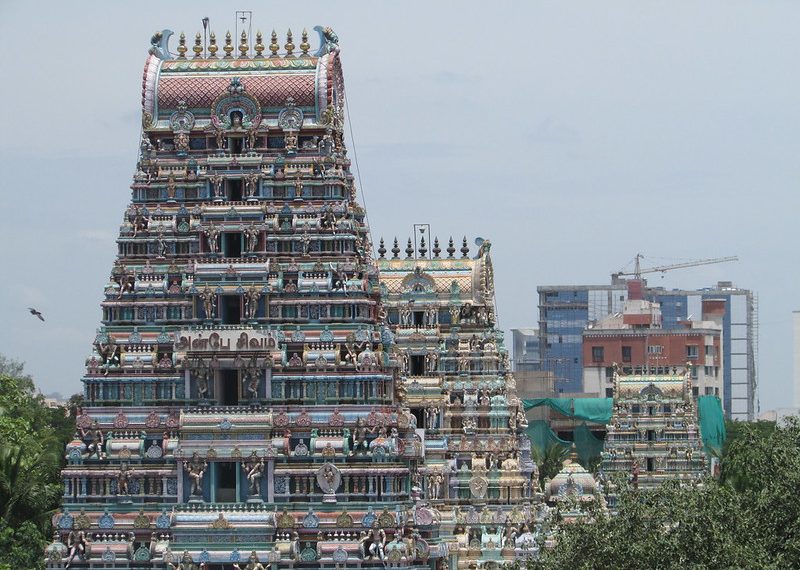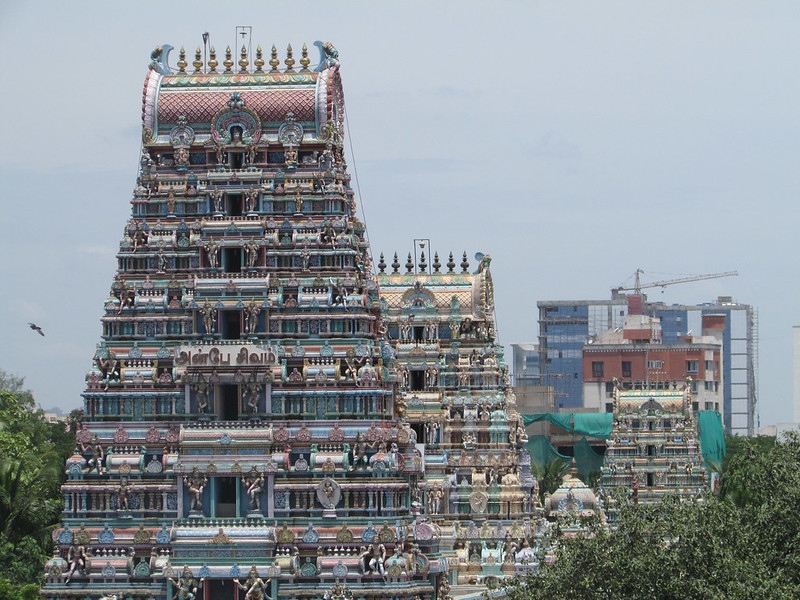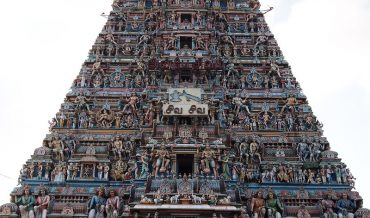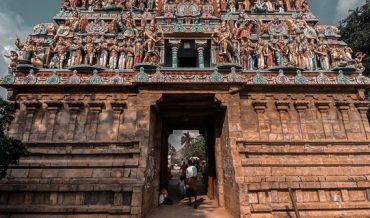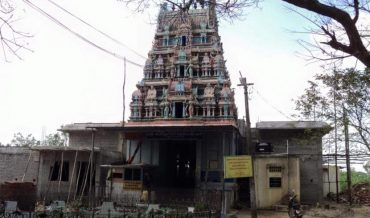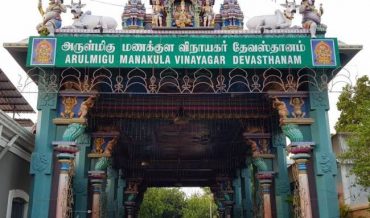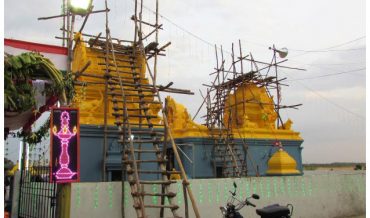
Marundeeswarar Temple Main Deity
Moolavar: Marundeeswarar (Marundu means medicine; Eswar is Bhagwan Shiv)
Utchavar: Thyagarajar
Amman/Consort: TiripuraSundari
Sthal Vriksh: SHAMI TREE / BANNI TREE/ VANNI MARAM – Vanni Tree (Prosopis Spicigera)
Sthal Theerth: Pancha Theertha
Agamam: Kameekam
approx: 1300 year old constructed
Marundeeswarar Temple is dedicated to Bhagwan Shiva, located in Thiruvanmiyur, Chennai adjacent to the beach of Bay of Bengal. It is one of the 275 Paadal Petra Sthalams and no Navagraha where the two of the most revered Nayanars (Saivite Sages), Appar and Tirugnana Sambandar have glorified the Temple with their verses during the 7th-8th century. The Temple has been widely expanded by Chola kings during the 11th century. The Temple has two seven tiered Gopuram, a huge pond, with the overall Temple area covering 1 acre. The Marundeeswarar Temple has been a place of curative worship for people with diseases.
Details of Deities in the Temple
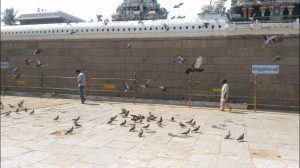
Pradakshina path, Marundeeswarar Temple
Other than the shrines of Bhagwan Shiva and Goddess Parvathi, shrines of Shri Vinayaka (3 Ganeshas who control all three time periods), adjacent to this a vedagama padasalai (School on learning & reciting of Vedas) is situated along with Gow Shala (Shed for cows), Shri Murugan (as Selva MuthuKumaraSwamy) with His consorts, Bhagwan Thyagaraja has a separate shrine before entering into Moolava Sannidhi from South entrance. Shri Nataraja and Sivakami facing South. Both are big and beautiful. Shri Veerabahu, Sage Arunagirinathar, Shri Dakshinamurthy, Bhagwan Brahma, Shri Mahavishnu, Maa Durga, Gajalakshmi, 108 Shiva Lingams, 63 Nayanmars, Nalvars, Shri Kedareswarar, Shri Jambukeswarar, Shri Ramanathar, Shri Arunachaleswarar with His consort Unnamulai Amman, Shri Sundareswarar and Shri Kalabairavar can be seen in the corridors. The idol of Sri Mahavishnu on the Eastern wall of the Sanctom deserve special mention. Between the East side Gopuram on the left side there is a Theertha Pond called Chithrai Kulam. Opposite to Chitrakulam there is a cultural hall called Thyagarajar Kalai Arangam. There is a separate shrine for Sri Valmiki Maharishi in this place in the middle of the ECR.
A Thirumurai mandapam has been set up in which Tirumura are sung daily since past 20 years. The shrine of Shiva, which has the idols of Shiva in his three forms, Theyagaraja, Marundeeswarar, and Nataraja. The last shrine is for Marundeeswarar’s consort, Goddess Thirupurasundari, who is actually Goddess Parvati.
Architecture of the Temple

Gopuram view from East, Marundeeswarar Temple
The Temple is believed to have partial feature of Pallava dynasty and partially with Chola art. The present architecture was built during the Chola dynasty in the 9th century, while later expansions are attributed to Vijayanagara rulers. The Temple has two entrances, one from East Coast Road and the other from West Tank Street both adorned by 5-tiered Gopuram. The Entrance from the West Tank Street has got three gates whereas the entrance from the East Coast Road has only one gate. Numerous images adorn the pillars of the Temple, while stucco figures adorn the Gopurams. The mandapam (hall) housing the Somaskanda form of Shiva has 36 massive pillars adorned with carvings. Devasriyan mandapam inside the Temple conducts Shaiva Sidhantha lectures every day between 7 pm and 8.30 pm.
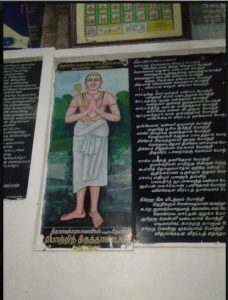
Inscriptions, Marundeeswarar Temple
The road starting from Marundeeswarar Temple, now called ECR (East Coast Road) was an important route during the Chola period and was known as Vadagaperuvazhi (means approach to Northern India), connecting the kingdom to places in Thanjavur and Andhra Pradesh. Inscriptions can be found in the shrine of Tripurasundari Amman dating back to the 11th century during the period of Rajendra Chola. The origins and antiquity of this Temple is corroborated by the inscriptions found in other Temples in the city namely Kapaleeswarar Temple, Virupaksheeswarar Temple and Thiruvidandai which bear testimony to Tiruvanmiyur’s existence. A new life has been put into this ancient worshiping place, first in the year 1903 and then in the 1970’s. This Temple along with Kapaleeswarar Temple and Thiruvottiyur Thyagarajaswamy Temple form the famous Trinity Sea Shore Temples of Thondai Mandalam. Since then the Marundeeswarar Temple has been a place of worship for people with diseases and various problems with their health.
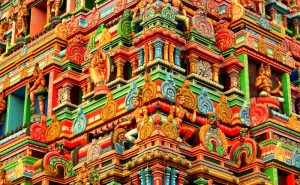
Marundeeswarar Temple Carvings on Gopuram
The Temple is maintained and administered by the Hindu Religious and Charitable Endowments Department of the Government of Tamil Nadu. The latest consecration (Maha Kumbhabhishekam) of the Temple after renovation was performed on 5th February 2020. On the same day of Sri Brihadeeswara Temple (Tanjore) Maha Kumbhabhishekam.
This Temple has a deep connectivity with all our Maharishis in Ramayana – Sattology follows:
- Shri Agasthiyar Maharishi worshiped Bhagwan Shiva here and was taught the science of “Oushadha Muligai” (medicinal herbs) by Bhagwan Shiva. Hence Bhagwan here is also known as “Sri Oushadeeswarar” and “Sri Marundeeswarar” (“Marundu” means medicine and “Eswarar” means Bhagwan Shiva in Tamil). Shri Agasthiya Maharishi was blessed with Bhagwan Shiva’s wedding darshan under the Vanni tree, the Sthal Vriksh of this Temple.
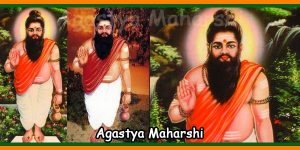
Agasthya Maharishi1
- Recognizing the penance of Sage Vasishta on Bhagwan Shiva, Indira sent his Kamadenu the divine cow with the sage. Once, the cow delayed to pour the milk for pooja. The angry sage cursed it to become an ordinary cow losing its divine status. He also suggested the cow to go to this place and worship Bhagwan Shiva under the Vanni tree to recover its divinity. As Kamadenu worshiped and offered her milk for the Bhagwan here, Bhagwan Shiva Linga appears white in colour. Hence, the God here is also known as “Palvanna Nathar” (“Palvannam” means “white as milk” in Tamil).
- According to Sattology Sage Valmiki was advised by Sage Narada to go to this Temple and worship Bhagwan to attain Moksha. When Sage Valmiki came there to worship Bhagwan Shiva, Kamadhenu ran in fear pressing its feet on the head of the Shivalinga, the scar of which is still visible on the presiding deity, also the hoof marks of Kamadhenu can be seen on Shiva Linga even today. Bhagwan Shiva is believed to have given darshan to sage Valmiki under this Temple’s Vanni tree. Bhagwan also believed to have performed his dance on a full moon day in the Tamil month of Panguni (March-April) when the sage Valmiki attained Moksha. Sage Valmiki was said to be blessed here. After this incident, this place was to be known as ThiruValmikiYur, after a long period of time, the name gradually changed to Thiruvanmiyur. There is a place present in Thiruvanmiyur called Valmiki Nagar in His honour.
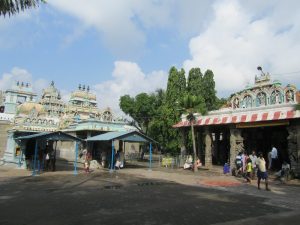
Marundeeswarar Temple, Left side Bhagwan Shiva, Right side Maa Parvathi
- Sage Sri Dhikshithar, a well-known Sanskrit scholar is also believed to have worshiped Bhagwan here. It is believed that once, during heavy floods, the sage could not see the Bhagwan’s face for worship. He prayed to the Bhagwan asking him to turn around. Bhagwan Shiva obliged and turned West to grace his darshan. Hence, in this Temple, Bhagwan Shiva’s shrine alone faces West whereas the other shrines face the East direction.
- Another Sattology says that, Bhagwan Brahma, Shri Mahavishnu, Sri Ram, Surya (Sun God), Chandra (Moon God) have worshiped Bhagwan Shiva of this Temple. The great Chola King Rajendran Chola is also believed to have worshiped the God here.
- Shri Markandeya Maharishi performed tapas (penance) and prayed Bhagwan Shiva here, also He gave darshan to Sri Markandeya Maharishi under the Vanni tree.
- Vedas and Devas are believed to have worshiped Bhagwan Shiva here. Hence the Bhagwan here is also known as “Sri Vedapureeswarar”
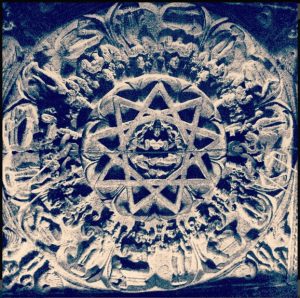
Marundeeswarar Temple, Sri Chakram carving on the ceiling of Maa Sanctom
- The Shiva Lingam for which Shri Hanuman performed pooja, The Lingam (Meenakshi Sundareswarar) that cured the curse of God Indra, the Lingam for which Shri Bharadhwaja Maharishi performed pooja are present here. Bhagwan Brahma is believed to have conducted a festival here for Bhagwan Shiva.
-
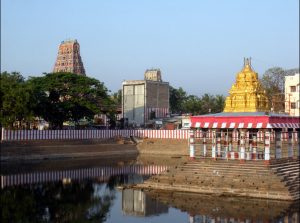
Pancha Theertham – Marundeeswar Temple Pond
This Temple has 5 Theerthams named as: Janma Nasini, Kama Nasini, Papa Nasini, Gyana Dayini and Moksha Dayini. These are believed to have originated from the “jada mudi” of Bhagwan Shiva. Gyana Dhayini theertham is said to have ceased to exist. Kamanasini and Moksha Dayini are in the form of wells. Janmanasini is in the form of Chitrakulam pond in front of East Gopuram. While the PapaNasini is a massive tank situated a little away from the East Gopuram
- Bhagwan Murugan (Karthikeya) is seen with his right leg on his peacock mount. He has a Vel in his hand.
- Sage Shri Arunagirinadhar has sang songs in praise of Bhagwan Murugan of this Temple in his revered Thirupugazh.
- As per another sattology Surya (Sun God) worshiped Bhagwan Shiva during night, hence important functions are held during night. Chandra (Moon God) got his curse wiped off by worshiping Bhagwan Shiva here.
Major Festivals celebrations in a year
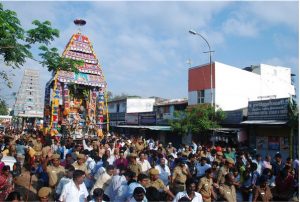
Rath yatra – Marundeeswarar Temple
- Panguni Brahmotsavam conducted every year for 10 days in the month of March – April.
- On 7th Day there will be a Chariot or Ratha Yatra festival, as shown in the image.
- On 9th day Sthal Vriksha Seva (Vanni Tree Seva)
- On 10th day Dance festival for the sake of Sri Valmiki Maharishi
- Maha Shivaratri during Feb-March, Ganesh Chaturthi, Skanda Shashti in Oct-Nov, Full Moon days, Krithika Nakshatra days, Margazhi Tiruvadirai in Dec-Jan. Regular Deepa/Diya Pooja is conducted during the month of Aashad (July-Aug) and celebrated with much fanfare in this Temple.
- During Brahmotsavam, 18 types of dances involving the festival image of Thyagaraja is a noteworthy unique feature of this Temple.
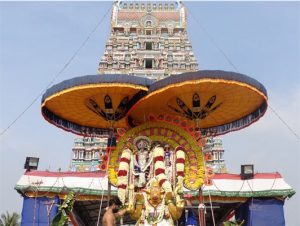
Utsava Moorthy, Marundeeswarar Temple
- During Brahmotsavam, 18 types of dances involving the festival image of Thyagaraja is a noteworthy unique feature of this Temple.
Source pics: Google and Sri. Arun Prasad
How to Reach Temple: Location from Google Maps – Click here
A video clip from Youtube about this Temple with comments in English for better understanding.
All information entered is personal to the author. Any modification or changes must be addressed to the author.

